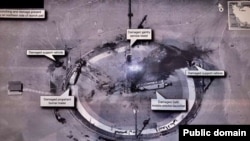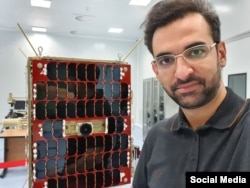Iranian Minister of Information and Communications Technology Mohammad Javad Azari Jahromi on Saturday, August 30m showed Nahid 1 (Venus 1) telecommunication satellite to journalists and photographers, responding to U.S. President Donald Trump's recent tweet about the spacecraft's failed launch.
A day earlier, President Donald Trump had posted a photo via Twitter of Iran's Imam Khomeini Space Center in Semnan, 219 kilometers (136 miles) southeast of the capital city, Tehran.
The satellite image showed the damage done to the facility by the explosion of what appears to have been a homemade "Safir" rocket during launch. Apparently, the rocket was being used in the attempted launch of Iran's Nahid-1 satellite.
In a later tweet Trump underlines that the U.S. was not involved in the incident. The disclaimer comes on the backdrop of well-known cyber efforts by the United States to disrupt Iran's nuclear and missile programs; not only during the Trump administration but starting years earlier.
A February 13 New York Times article suggested the reason for the failure of two previous Iranian space launches this year might have been "part of an expanding campaign by the United States to undercut Tehran’s military and isolate its economy." In an elaborate and clandestine effort, the Times reported that the U.S. arranged for faulty parts to be delivered to Iran, which would ultimately create such incidents.
Commercial satellite imagery from Planet Labs made available on Friday showed a plume of smoke rising from the space center's launch pad. But the photo posted by President Trump was a much higher-resolution, black and white photo, a resolution that suggested it came from a National Reconnaissance Office satellite.
An unnamed Iranian official also confirmed to Reuters the incident was caused by “some technical issues and it exploded but our young scientists are working to fix the problem.”
The official, speaking on condition of anonymity, gave no further details.
Facing media criticism for publishing a presumably "classified" image, the president resolved the question hours later on Friday night on his way to Camp David by noting, "We had a photo, and I released it, which I have the absolute right to do."
However, publishing classified images is not unprecedented. President John F. Kennedy declassified photographs of Soviet missile sites during the Cuban Missile Crisis in 1962, and President George W. Bush also declassified pictures of Iraq in 2003 to support Washington's case against Saddam Hussain.
Responding to President Trump, Azari Jahromi posted a picture of himself along with the telecommunication satellite, saying, "Me & Nahid 1 right now. Good Morning Donald Trump!"
Nevertheless, Azari Jahromi preferred not to comment on the alleged incident at Imam Khomeini Space Center in Semnan.
We have no concrete information on what exactly has happened in Semnan Space Center, and this is better to be explained by "our friends," Azari Jahoromi maintained without elaborating on the meaning of "our friends."
Furthermore, he reiterated that as far as his ministry was concerned, Nahid 1 satellite was undamaged, and nothing had happened during the test for launching it.
The Islamic Republic's space program is supervised by the country's Ministry of Defense that has not yet reacted to the alleged explosion in Semnan.





